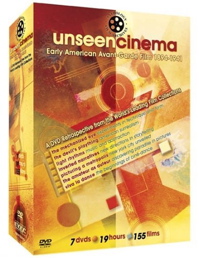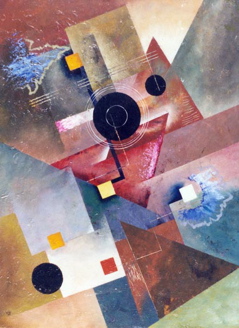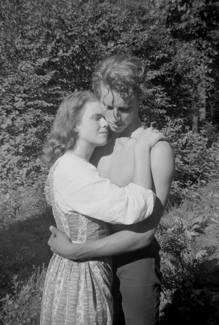| Release List | Reviews | Price Search | Shop | Newsletter | Forum | DVD Giveaways | Blu-Ray/ HD DVD | Advertise |
| Reviews & Columns |
|
Reviews DVD TV on DVD Blu-ray International DVDs Theatrical Reviews by Studio Video Games Features Collector Series DVDs Easter Egg Database Interviews DVD Talk TV DVD Talk Radio Feature Articles Columns Anime Talk DVD Savant HD Talk Horror DVDs Silent DVD
|
DVD Talk Forum |
|
|
| Resources |
|
DVD Price Search Customer Service #'s RCE Info Links |
|
Columns
|
 |
Unseen Cinema |

|
Unseen Cinema - Early American Avant Garde Film 1894-1941 Image / Anthology Film Archives 1894-1941 / B&W mostly / 1:37 flat full frame / 19 hours / Street Date October 18, 2005 / 99.99 Produced for DVD by David Shepard Curator Bruce Posner |
This monster collection contains 155 short films and excerpts spanning the first 45 years of the movies, most of which are avant-garde in nature. Occasionally the net is cast a little wider. There's a bit of overlap with the Treasures from American Film Archives and Avant-Garde: Experimental Cinema of the 1920s and '30s disc sets, but with 7 full discs of content, this collection can stand on its own.
Curator Bruce Posner doesn't waste time with preliminaries, as each disc comes with plainwrap text pages that introduce one film after another in quick succession. Although arranged into seven themes, each with its own disc, the content ranges all over the map from European-styled 'classics' to interesting films from people we frankly never heard of. Posner's collection shows that American filmmaking artisans were hard at work in both 35mm and 16mm from the late 1920s on, and he includes an essay that documents burgeoning film culture at work in places like Santa Fe New Mexico at the beginning of the depression.

It's not possible to describe or even name all the films, and the discs are each like a little treasure map to discoveries. Besides the expected essays on raindrops and ocean waves, we get some fairly amazing abstract films like Douglass Crockwell's Simple Destiny Abstractions, amazingly detailed animations that defy analysis. Other filmmakers contribute extremely complicated high-quality optical work (Watson and Webber's The Fall of the House of Usher) or equally mystifying pin-board animation, as seen in Alexandre Alexieff and Claire Parker's Night on Bald Mountain.
Some of the best material here is from Hollywood, directly or indirectly. Montage and cinema theorist Slavko Vorkapich is on hand with uncut original versions of his montages from big MGM pictures. One such mini-epic gives an impression of an entire Napoleonic war in two minutes. His masterpiece is the full-length version of the "Furies" opening montage to Hecht and MacArthur's Crime Without Passion. This is the disturbing film featuring three banshees that fly down the streets of Manhattan, smashing skyscraper windows and laughing at the sinners within.
We get an Ernst Lubitsch montage of a wild flapper dance orgy from 1926's So this is Paris that seems to go on for an entire reel. And Busby Berkeley's formal abstractions in his "By A Waterfall" and "Lullabye of Broadway" numbers fit in perfectly with the more esoteric films around them.
We've read about films financed by the depression-era WPA and this is the first chance I've gotten to see any. Elia "Gadget" Kazan shows up in a strange socialist movie about bums in New York. Several pictures sponsored by Labor Unions openly fight Fascism in 'alternative newsreels' that expose illegal business thuggery and a reactionary murder cult known as The Black Legion. Names later associated with the blacklist show up frequently in these pictures. It's fascinating to see what it was all about; one pro- organized labor film is narrated by Paul Robeson.
Unseen Cinema - Early American Avant Garde Film 1894-1941 is an abstract cinema course in a box that encompasses much more than we ever saw back at UCLA in the 1970s. It's organized onto seven discs entitled The Mechanized Eye, The Devil's Plaything, Light Rhythms, Inverted Narratives, Picturing a Metropolis, The Amateur as Auteur and Viva La Dance. Contributors to on-screen notes include archivists and producers Bruce Posner and David Shepard, Kevin Brownlow, R. Bruce Elder and Jan-Christopher Horak.
The range of filmmakers is fairly amazing. Besides Vorkapich, Berkeley and Lubitsch mentioned above, there are films representing Norman Bel Geddes, Billy Bitzer, David Bradley, Mary Ellen Bute, Joseph Cornell, James Cruze, Sergei Eisenstein, Walker Evans, Oskar Fischinger, Robert Flaherty, Victor Fleming, Robert Florey, D.W. Griffith, Leo Hurwitz, Lewis Jacobs, Jay Leyda, Norman McLaren, William Cameron Menzies, Edwin S. Porter, Man Ray, Ralph Steiner, Paul Strand, Charles Vidor, Lois Weber, Herman G. Weinberg, and Orson Welles.
 Charlton Heston in David Bradley's Peer Gynt (1941).
Charlton Heston in David Bradley's Peer Gynt (1941).
The list of films that one usually only sees as entries in film books, is endless. Sergei Eisenstein's footage from his unfinished Mexican film is here, as are three sections from David Bradley's Peer Gynt. It stars Charlton Heston well before his Hollywood career. Charles Vidor's 1929 version of Bierce's "An Occurrence at Owl Creek Bridge" is here. Silent experiments and abstract animation films abound, with refined titles like Light and Abstraction, Synchromy No. 2, Parabola and Rhythm in Light. Some films start with filmmakers' title cards announcing their artistic intention: "Music can be visual, seen as well as heard." One entire disc is essentially 'home movies.'
Some films have original soundtracks, and many more often shown silent have newly recorded tracks. Some are original compositions by artists like George Antheil and Marc Blitzstein. Featured new music is by Donald Sosin, Rodney Sauer, Guy Livingston, Paul A. Lehrman, Neal Kurz and Eric Beheim.
Besides curator Posner's text essay, individual discs have galleries of photos of some of the filmmakers. The quality on all the pictures is exellent; the color on a few films from the 1940s has aged poorly.
The collection of archives and contributors for the disc set have an Unseen Cinema - Early American Avant Garde Film 1894-1941 Web page with full information on its contents.
On a scale of Excellent, Good, Fair, and Poor,
Unseen Cinema - Early American Avant Garde Film 1894-1941 rates:
Movie: Excellent
Video: Excellent
Sound: Excellent
Supplements: Essay, stills.
Packaging: Seven slim cases in card box
Reviewed: October 30, 2005
Review Staff | About DVD Talk | Newsletter Subscribe | Join DVD Talk Forum
Copyright © DVDTalk.com All rights reserved | Privacy Policy | Terms of Use
|
| Release List | Reviews | Price Search | Shop | SUBSCRIBE | Forum | DVD Giveaways | Blu-Ray/ HD DVD | Advertise |





